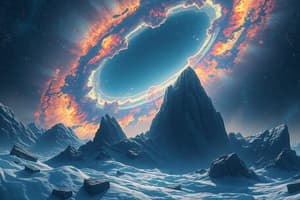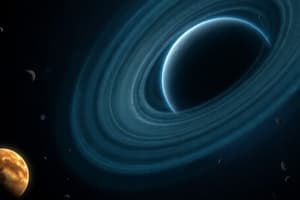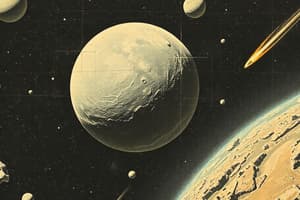Podcast
Questions and Answers
What are comets often compared to?
What are comets often compared to?
Dirty snowballs
Comets spend most of their lives far away from the ______ in the distant reaches of the solar system.
Comets spend most of their lives far away from the ______ in the distant reaches of the solar system.
Sun
A comet's tail always points towards the Sun.
A comet's tail always points towards the Sun.
False (B)
What are the two main sources of comets?
What are the two main sources of comets?
What are comets primarily made up of?
What are comets primarily made up of?
What is the defining characteristic that distinguishes short-period comets from long-period comets?
What is the defining characteristic that distinguishes short-period comets from long-period comets?
Which part of a comet is described as a dense cloud of water, carbon dioxide, and other neutral gases sublimed from the nucleus?
Which part of a comet is described as a dense cloud of water, carbon dioxide, and other neutral gases sublimed from the nucleus?
The ion tail of a comet is composed of dust particles driven off the nucleus by escaping gases.
The ion tail of a comet is composed of dust particles driven off the nucleus by escaping gases.
What is the name of the largest asteroid in the main asteroid belt?
What is the name of the largest asteroid in the main asteroid belt?
Asteroids are remnants of material left over from the formation of the solar system.
Asteroids are remnants of material left over from the formation of the solar system.
What is a meteoroid?
What is a meteoroid?
Match the following terms with their descriptions:
Match the following terms with their descriptions:
Flashcards
Comets
Comets
Small, icy bodies that orbit the Sun, primarily composed of frozen gases, dust, and rocky material.
Kuiper Belt
Kuiper Belt
The region of the Solar System beyond Neptune, containing icy bodies and debris left from the formation of the planets.
Oort Cloud
Oort Cloud
A vast shell surrounding the Solar System, composed of trillions of icy bodies, believed to be the source of many long-period comets.
Comet Nucleus
Comet Nucleus
Signup and view all the flashcards
Comet Coma
Comet Coma
Signup and view all the flashcards
Comet Dust Tail
Comet Dust Tail
Signup and view all the flashcards
Comet Ion Tail
Comet Ion Tail
Signup and view all the flashcards
Asteroids
Asteroids
Signup and view all the flashcards
Meteoroids
Meteoroids
Signup and view all the flashcards
Meteor
Meteor
Signup and view all the flashcards
Meteorite
Meteorite
Signup and view all the flashcards
Cometary Orbit
Cometary Orbit
Signup and view all the flashcards
Meteor Shower
Meteor Shower
Signup and view all the flashcards
Planetesimals
Planetesimals
Signup and view all the flashcards
Oort Cloud
Oort Cloud
Signup and view all the flashcards
Kuiper Belt
Kuiper Belt
Signup and view all the flashcards
Comet Nucleus
Comet Nucleus
Signup and view all the flashcards
Comet Coma
Comet Coma
Signup and view all the flashcards
Comet Dust Tail
Comet Dust Tail
Signup and view all the flashcards
Comet Ion Tail
Comet Ion Tail
Signup and view all the flashcards
Cometary Outgassing
Cometary Outgassing
Signup and view all the flashcards
Solar Radiation Pressure
Solar Radiation Pressure
Signup and view all the flashcards
Solar Wind
Solar Wind
Signup and view all the flashcards
Cometary Period
Cometary Period
Signup and view all the flashcards
Short-Period Comet
Short-Period Comet
Signup and view all the flashcards
Long-Period Comet
Long-Period Comet
Signup and view all the flashcards
Asteroids
Asteroids
Signup and view all the flashcards
Meteoroids
Meteoroids
Signup and view all the flashcards
Meteor
Meteor
Signup and view all the flashcards
Meteorite
Meteorite
Signup and view all the flashcards
Study Notes
Comets
- Comets are remnants of planet formation, approximately 4.6 billion years old.
- Unlike asteroids, which are mainly rock and metal, comets resemble "dirty snowballs".
- They consist of frozen gases (carbon dioxide, methane, ammonia), water ice, and embedded dust and rocky material.
- As comets approach the Sun, solar radiation vaporizes the icy surface, creating a gaseous coma and a visible tail.
- The tail always points away from the Sun, often appearing to trail behind but sometimes alongside or in front of the comet.
Comet Origins
- Comets originate primarily from the Kuiper Belt and the Oort Cloud.
- The Kuiper Belt is a disk of icy bodies extending from Neptune's orbit to about 50 AU from the Sun.
- The Oort Cloud is at the edge of the Sun's gravitational influence, encompassing a spherical cloud of icy bodies.
- Short-period comets (orbiting the Sun in 200 years or less) usually originate from the Kuiper Belt.
- Long-period comets take hundreds or thousands of years to orbit the Sun and originate from the Oort Cloud.
Comet Structure
- Comets have a nucleus, coma, and tails.
- The nucleus is a relatively small, solid, stable part composed of ice, gas, and a little dust.
- The coma is a dense cloud of water, carbon dioxide, and other gases that sublimate from the nucleus.
- The dust tail is composed of dust particles ejected from the nucleus, typically up to 10 million km long.
- The ion tail is composed of plasma, and several hundred million km long, laced with rays caused by interactions with the solar wind
Asteroids
- Asteroids are rocky and metallic objects that orbit the Sun.
- They are also referred to as minor planets.
- Asteroids are leftovers from the formation of the Solar System.
- They are primarily located in the asteroid belt, which exists between Mars and Jupiter.
- Ceres is the largest asteroid.
Meteoroids, Meteors, and Meteorites
- A meteoroid is a small, solid particle that orbits the Sun.
- A meteor is a meteoroid that burns up in Earth's atmosphere.
- A meteorite is a meteoroid that survives its passage through the atmosphere and lands on Earth's surface.
- Meteor showers occur when Earth passes through a trail of debris left by a comet.
Oort Cloud
- The Oort cloud is an enormous, spherical cloud encompassing our planetary system.
- It extends approximately two to three light-years from the Sun.
- This distance is considered the edge of the Sun's gravitational influence.
Kuiper Belt
- The Kuiper Belt is a region in the Solar System beyond the orbits of the eight major planets.
- It stretches from 30 AU to approximately 50 AU from the Sun.
- This region is similar to the asteroid belt; it contains many small, icy bodies, remnants of the Solar System's formation.
- It is significantly larger and more massive than the asteroid belt.
Studying That Suits You
Use AI to generate personalized quizzes and flashcards to suit your learning preferences.




